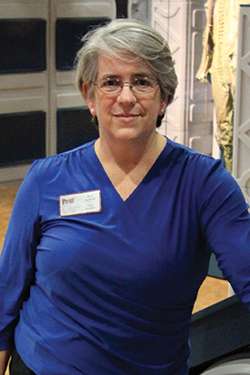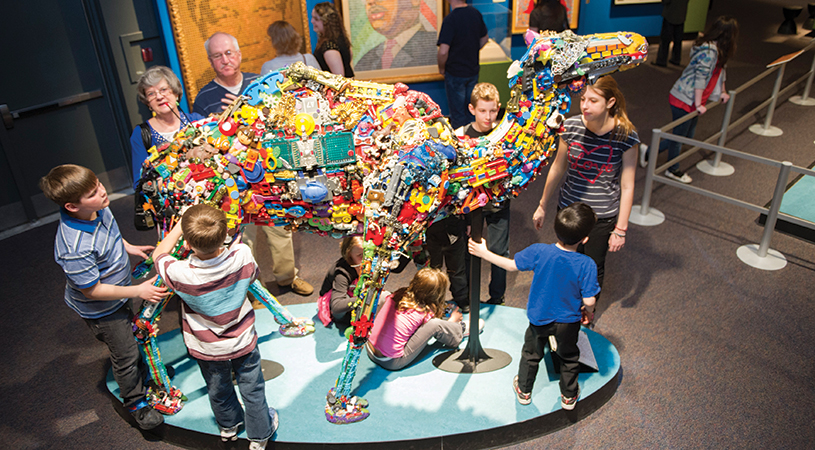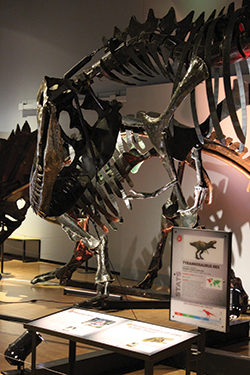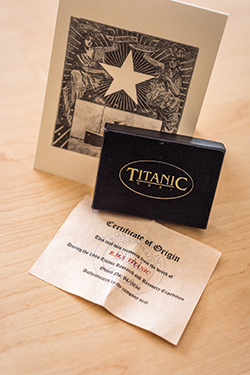As the PRM prepares its largest exhibition to date, staff members reflect on what it takes to be a good host.
There are more than 35,000 museums and related facilities (such as planetariums, aquariums, nature centers, historic centers and more) in the United States, according to the Institute of Museum and Library Services. That includes more than 1,300 in Illinois and over two dozen in Greater Peoria alone—a pack of institutions led by the Peoria Riverfront Museum. While the PRM’s Giant Screen Theater and Dome Planetarium offer educational programming and entertainment year-round, its exhibitions hold a different level of intrigue.
This November, the museum is set to open Titanic: The Artifact Exhibition… and like every show that comes through its doors, hosting such an exhibition is no easy feat. From planning to setup to teardown, the process involves acute diligence, attention to detail and collaboration among staff to ensure its success.
Flurry of Activity Of the PRM’s five exhibition galleries, the International Feature Gallery (IFG) is the largest. According to Ann Schmitt, Vice President of Programs, the galleries—and the IFG in particular—were designed to accommodate the wide variety of displays that come and go. “The museum is designed to be flexible,” she explains. “There are large walls that will open—we call them barn doors—that connect that gallery to the one adjacent to it. So if there’s a large exhibit… it can start in the IFG and go into the second gallery, which is typically for our permanent collection, but does double duty.”
Of the PRM’s five exhibition galleries, the International Feature Gallery (IFG) is the largest. According to Ann Schmitt, Vice President of Programs, the galleries—and the IFG in particular—were designed to accommodate the wide variety of displays that come and go. “The museum is designed to be flexible,” she explains. “There are large walls that will open—we call them barn doors—that connect that gallery to the one adjacent to it. So if there’s a large exhibit… it can start in the IFG and go into the second gallery, which is typically for our permanent collection, but does double duty.”
Bringing an outside exhibition into the museum is neither quick nor easy. It begins with a curatorial planning team, which brainstorms potential exhibitions; then a larger staff exhibit team, including marketing and operations personnel, discusses what they’d like to see—and what would fit best in terms of both style and budget. Finally, a programs committee consisting of board members and community volunteers makes selections for the approval of the full board. And that’s only to select an exhibition… getting it to Peoria is a whole other process.
“It can take [about six months] between the initial interest and the contract being signed,” Schmitt explains—and sometimes an exhibition will fall through due to the prolonged timetable. “We had one that we really wanted for 2017, and by the time we got through all those steps, it had been booked somewhere else.”
But if all goes according to plan, the museum begins contract negotiations with the company that owns the exhibit. Agreements must be struck on everything from staff and security to environmental factors—ensuring that humidity and temperature don’t harm delicate items, for example. Ideally, the contract is signed roughly a year and a half before the exhibition opens, allowing ample time for the museum to prepare programming and marketing while keeping in mind the interests of its patrons.
“We need to have a certain amount of nimbleness,” Schmitt explains. “We have to be able to react quickly to current interests, so 18 months is a good envelope [of preparation time] to have… It seems like a really, really slow ramp-up. And when it comes time to actually install the exhibit, it’s an incredible flurry of activity.”

An “Edutaining” Display
When the exhibition finally arrives at the museum, all the pieces are carried by semi-trucks, carefully controlled for environmental needs. Determining the right place for each piece, Schmitt adds, is a mix of input from the exhibition company and the museum’s exhibit designer. “Some of the larger [companies]… want a lot of control over the layout,” she explains. “They need to know where the power sources are, which walls are moveable… and then they send back a proposed layout that our exhibit designer looks at and says, ‘This will work… [or] this won’t work.’”
Once it’s up and running, the exhibition is supplemented with additional programming, often utilizing the Giant Screen Theater and Planetarium to provide fresh opportunities for learning. “It’s a constant learning curve,” says Lottie Phillips, the museum’s volunteer and learning coordinator. “Part of the challenge and excitement is learning as much as we can—so that we can come up with good programming, so we have the knowledge to select good people to come and lecture.”
“That’s a goal that has changed over the decades,” Schmitt adds. “You have to walk that line between education and edutainment… Our goal is to inspire lifelong learning—but you can’t do that if you don’t get people in the door. So you have to make it appealing to people. And once they’re there, educate them.”
When the exhibition wraps up, the museum staff helps the curators carefully pack everything back into semis, ready for travel to the next destination. The task of moving one exhibition out and the next one in can be tricky, Schmitt says, and takes much longer than one might expect. “The changeover time can really mess things up,” she notes. “It’s going to take at least two weeks to get out of one museum, and usually three weeks to get into another. So if Museum X has our [next] exhibit until the very end of May, and we want to open it up at the beginning of June… it may not happen that way.”

Titanic-Sized Ambitions
Titanic: The Artifact Exhibition is set to be the PRM’s largest exhibit yet, according to Schmitt, spanning the entire IFG and its adjacent gallery—nearly 7,000 feet of space all together. It will also be highly interactive. Upon entry, visitors will receive a “boarding pass” with the name of a real Titanic passenger. Moving through the exhibit space, they can examine replicas of the ship’s interior, including real artifacts pulled from the wreckage, and touch a large mock iceberg, layered with two inches of ice, to feel what it was like to be in the water as the ship went down. When their journey is complete, they can review a passenger list to determine if they survived—or perished with the ship.
The high level of visitor interaction is largely what makes the exhibition so interesting, Phillips notes. “Even if you’re not interested in history, it places you where these people were. [You may ask] ‘What was going on at the time? Why should I care about that?’ Then you step into the exhibit, and suddenly
you’re transported back into that time period, and you’re really able to get a sense of… what [people were] going through at that point in time.”
Titanic is curated by Premier Exhibitions, an industry leader with major exhibits touring the world. Mark Lach, the firm’s creative director, notes the exhibit’s distinctive atmosphere, with delicate historical items and interactive displays converging to tell the real-life story of a tragedy made famous through pop culture—thanks in part to the 1997 hit movie. “It’s a unique experience people have, both through history and the theatrical things over the years,” he says. “[It’s a combination of] all the things that have brought people bits and pieces of the story, but never have been able to bring the real objects, the real artifacts, the things that were pieces of the ship… [and] in some cases, pieces of people’s lives.”
With the PRM’s location near a major river, Lach believes it is an exciting place for a partnership to thrive. “We want to find the right museum that has the right energy, enthusiasm, professionalism, quality of staff, quality of venue… and probably more importantly, a mutual enthusiasm of working together… [to provide exhibits] that are interesting and thought-provoking and experiential.”
Invigorating Experiences
Like every aspect of running a museum, exhibitions come with ups and downs. Some perform better than others; their success, Schmitt says, can be determined by the number of patrons coming through, where they came from, memberships gained during the run, and ticket sales, among other metrics. And sometimes, exhibit pieces and the displays designed to accompany them don’t always make it through intact—especially ones designed for children. “I’ve learned my lesson,” she jokes. “If you put something together for kids, it better be indestructible.”
 Each exhibition is unique, of course, but they all require meticulous teamwork, research and planning. That means each staff member must fulfill their role, and then some. “My job is like everybody else’s job at the museum… We have one last thing on our job description: Other duties as necessary,” Schmitt says with a laugh. “No one person can put on an event—especially a large event—by themselves. So everybody works together. And if you looked at what we did over a typical week, you would get an idea of the diversity of jobs that any one of us do.”
Each exhibition is unique, of course, but they all require meticulous teamwork, research and planning. That means each staff member must fulfill their role, and then some. “My job is like everybody else’s job at the museum… We have one last thing on our job description: Other duties as necessary,” Schmitt says with a laugh. “No one person can put on an event—especially a large event—by themselves. So everybody works together. And if you looked at what we did over a typical week, you would get an idea of the diversity of jobs that any one of us do.”
With Titanic: The Artifact Exhibition scheduled to open in November, the museum is already planning for next year. GENOME: Unlocking Life’s Codes, which tells the story of DNA and genomic contributions to health and disease, will debut in March 2017, while Playing with Light, an interactive exhibit exploring the science of light, will follow in June. And as always, Schmitt, Phillips and the PRM staff are there to make sure every detail is in place—and to continue offering an invigorating educational experience that keeps visitors coming back for more. a&s
Titanic: The Artifact Exhibition runs from November 12, 2016 to March 12, 2017. For more information, visit peoriariverfrontmuseum.org.


